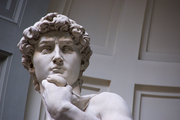
David by Michelangelo
Michelangelo's David is one of the most iconic sculptures in Western art, created between 1501 and 1504. Standing at over 5 meters tall, it represents the biblical hero David, poised before his battle with Goliath. The sculpture highlights Michelangelo's mastery of anatomy and the human form, capturing both physical strength and intense concentration. Carved from a single block of marble, David symbolizes the Renaissance ideals of human beauty, power, and intellect. It's currently housed in the Galleria dell'Accademia in Florence, Italy.

Italian Landscape
Italian Landscape with Umbrella Pines is an 1807 painting by Dutch artist Hendrik Voogd, renowned for his landscape paintings in the neoclassical style. After settling in Rome, Voogd drew inspiration from the Italian countryside, particularly the iconic umbrella pines and the play of light in the rolling hills. The painting depicts a vast Italian landscape dominated by a row of majestic umbrella pines, whose distinctive silhouettes set the scene. This work captures not only the natural beauty of the Italian landscape but also the romantic fascination with the harmony between humans and nature. Voogd skillfully combines a precise representation of nature with a strong sense of composition and light, characteristic of his oeuvre. The painting reflects the influence of both the Dutch tradition of landscape painting and the classical ideals he embraced in Italy.

The Threatened Swan
"The Threatened Swan" is a painting by Dutch artist Jan Asselijn, created around 1650. It depicts a life-sized swan fiercely defending its nest from a dog, with wings outstretched and an aggressive stance. The painting is known for its dramatic portrayal of the swan's protective instincts.
Over time, the painting gained political significance during the Dutch Republic era, as the swan was interpreted as a symbol of patriotism. It was seen as representing the Dutch statesman Johan de Witt, who defended the country from enemies. The painting is now part of the Rijksmuseum collection in Amsterdam.

Portrait of Joseph Roulin
This painting is one in a series of portraits Vincent van Gogh's made of Joseph Roulin, a postman in Arles. Van Gogh painted Roulin multiple times, depicting him in various poses and color schemes. The series includes several oil paintings, as well as drawings and prints, showcasing Van Gogh's deep friendship with Roulin, whom he admired for his kindness and strong character.
In these portraits, Roulin is usually shown in his postal uniform, with bold, expressive brushstrokes and vibrant colors. Van Gogh used vivid blues, greens, and yellows to capture both the physical likeness and the inner personality of his subject, often reflecting his own emotional state through these choices.
The series is significant because it illustrates Van Gogh’s belief in portraying ordinary people with dignity and emotional depth. The portraits can be found in major museums, including the Museum of Modern Art, the Van Gogh Museum, and the Kröller-Müller Museum.

Self-Portrait Rembrandt van Rijn
Rembrandt van Rijn, one of the greatest Dutch painters of the 17th century, created numerous self-portraits throughout his life, offering a vivid exploration of his evolving emotions and personal circumstances. His self-portraits reveal not only his technical mastery but also his introspection and psychological depth. There are around 80-100 known self-portraits by Rembrandt, including paintings, etchings, and drawings, making him one of the most self-documented artists in history.

Martineau - Composition of faces
Anton Martineau (1926-2017) was a Dutch painter and poet known for his expressive and often raw style. He is associated with the CoBrA movement, although he was never an official member. His work is characterized by a spontaneous, emotional way of painting, often using bright colors and wild, energetic brushstrokes.
A striking aspect of Martineau's work is his composition of faces. In many of his paintings we see faces that are distorted and fragmentary, as if he is trying to capture the inner emotions and complexities of human beings. These faces are rarely realistic, but rather abstract or symbolic. Martineau drew inspiration from the human condition and existential themes, such as fear, desire and joy. His compositions of faces sometimes appear simultaneously joyful and terrifying, reflecting a sense of intensity and duality in life.
The way he shapes faces often feels almost poetic, which is consistent with his background as a poet. With him, the face becomes a kind of mask that represents not only a person's physical appearance, but especially the inner world. The eyes and mouths in his works are often exaggeratedly large or sharply delineated, emphasizing the emotional charge. As a result, the figures in his paintings come alive in a way that invites introspection and emotional involvement from the viewer.
His work, in which he seeks a synthesis between image and poetry, remains powerful and evocative, and his faces often capture the imagination more than realistic portraits would.